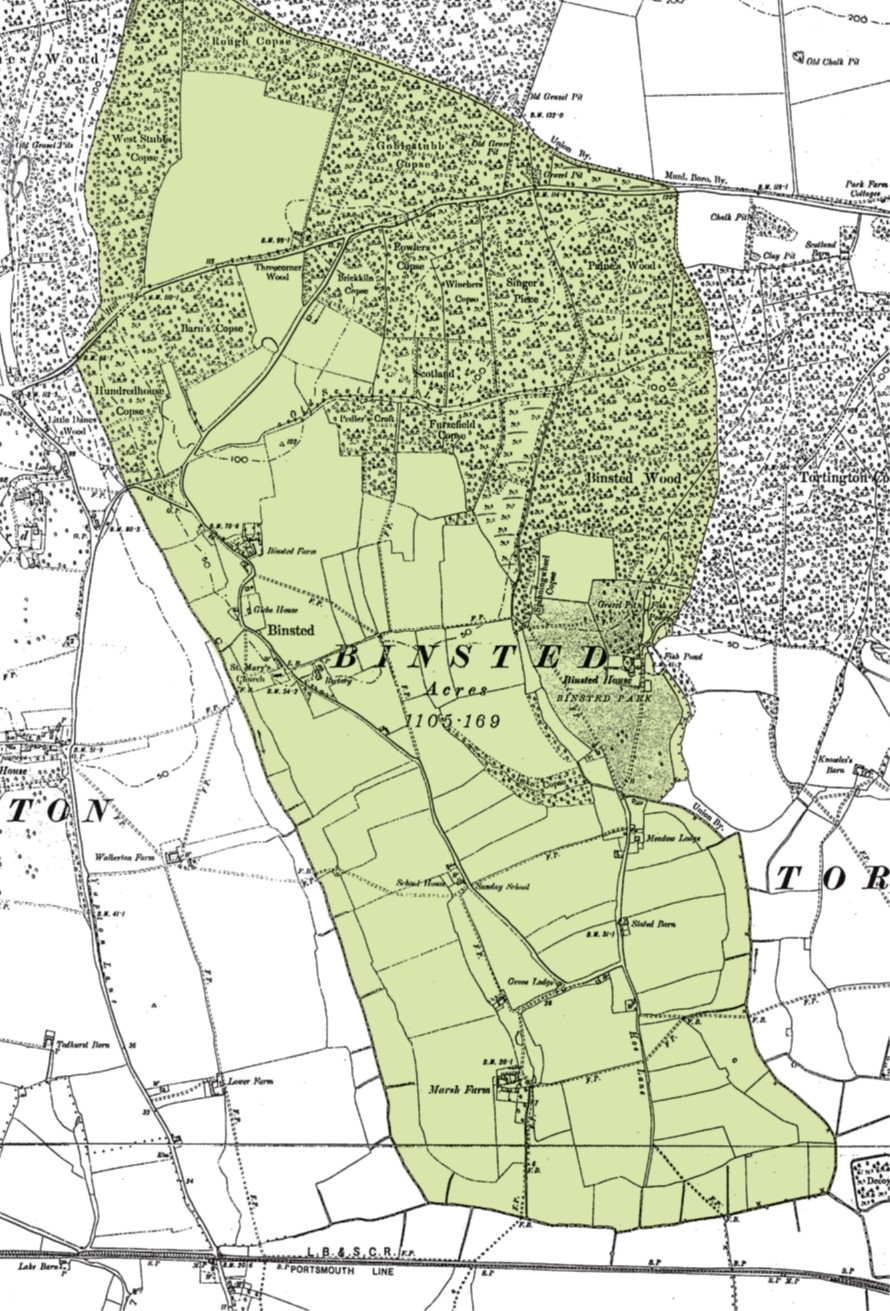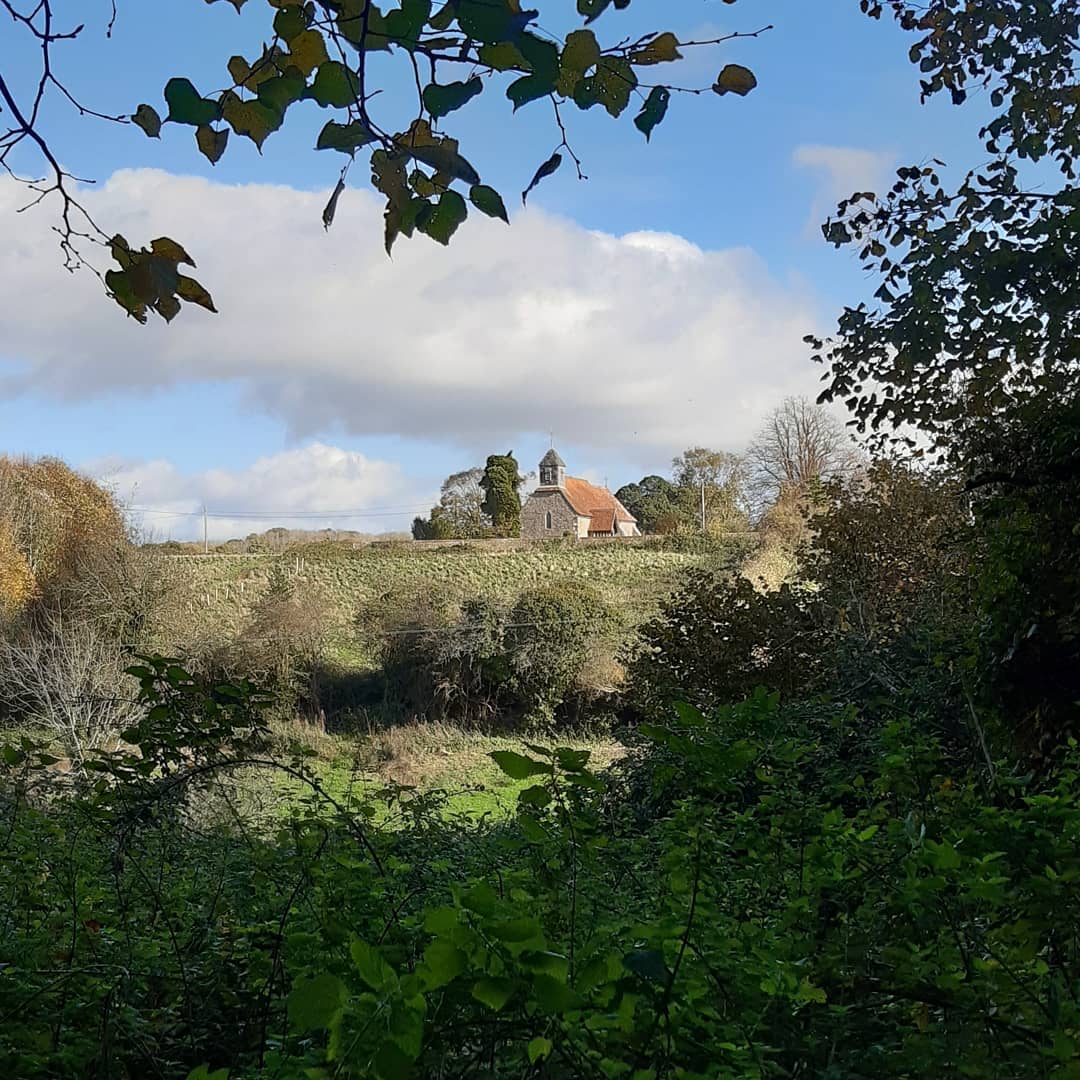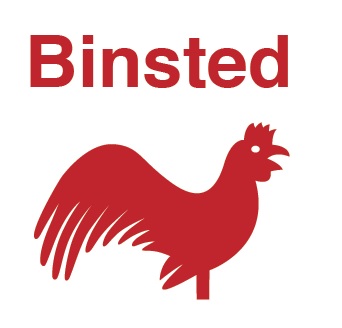 ‘Intricate secrecy and delicate topography’: this was how the Campaign to Protect Rural England described Binsted during the National Park Public Inquiry of 2004. CPRE called both Binsted and Tortington ‘parishes of profound but understated beauty’. Secret, and understated, because Binsted’s beauty depends partly on something that has not happened, and to see its history, you need to know what you are looking for.
‘Intricate secrecy and delicate topography’: this was how the Campaign to Protect Rural England described Binsted during the National Park Public Inquiry of 2004. CPRE called both Binsted and Tortington ‘parishes of profound but understated beauty’. Secret, and understated, because Binsted’s beauty depends partly on something that has not happened, and to see its history, you need to know what you are looking for.
Looking back in time
‘Nucleation’, or villages gathering into a settlement surrounded by fields, took place from the 8th century onwards; it never happened in Binsted. So the landscape, with its spread-out village and its mainly small fields and ‘assarts’ (fields taken out of woodland), looks very old. The two larger fields in the centre of the parish were the common fields, worked in strips by different villagers.
An independent parish till the 1930s, Binsted was self-sufficient, with all the needed types of land – woods, sandpits, brooks, arable, pasture, meadows, marshes – sloping gently towards the south and the sea, and its own church and poor house. (Binsted is now part of Walberton parish.)
Marshy brooks on three sides, and a steep valley to the west, defined much of the old parish boundary. They were impassible and no roads crossed them – except the one way in, Hedgers Hill, across the steep Binsted valley. The short, atmospheric tree tunnel connecting Binsted to the modern A27 was made in the 18th century, according to James Kenny, Chichester District archaeologist.
Within this isolation, Binsted Lane curves round in a U-shape, connecting the different types of land and the three historic estates or farms with their cottages (Church Farm, Marsh Farm and Binsted Ball farm). Binsted Lane East (the eastern arm of the U) connects through to Tortington, but has not been made up in recent times, and Satnav sends many vehicles to their undoing in its large potholes. Only bicyclists, walkers and riders can get through Binsted Park (the ‘pocket park’ within the woods, associated with former Binsted House) to Tortington’s lanes and Arundel. Hence Binsted is quiet and peaceful.
 Hidden history
Hidden history
An Iron Age earthwork – a steep bank, double in places - passes through the entire parish from south to north, using the side of the Binsted Rife Valley as an extra defence, passing under the pub and the church and far up into the Downs. It joins with a similar earthwork at the top of the Downs, War Dyke, which descends to the Arun. Together with the loops of the river and the southern boundary brook, this earthwork defended a separate Iron Age settlement or ‘oppidum’, possibly for trading with the Romans.
Before the Norman conquest of 1066, Binsted was the meeting place of the Binsted Hundred, a countryside administration area, which reached up to the top of the Downs and down to the sea. Its surviving Anglo-Saxon ‘moot mound’, where the courts met, has recently been identified next to Hundred House Copse. It is right next to the remains of the Iron Age bank – now hardly visible in the field, but massive in the woods. Moot Mounds were often placed so as to borrow authority from ancestral monuments.
Binsted’s 12th-century church is built in a commanding position on the lip of the valley, on top of this earth bank, perhaps in an effort to assert Christianity over the ‘pagans’ who built the earthwork.
With its own clay and water, Binsted had thriving tile and pottery businesses in the 13th and 14th centuries – the kilns are still there, buried under farmland and gardens.
A haven for wildlife
Binsted Woods, 250 acres of varied woodland, are remarkable as well as atmospheric, with many fallen trees. As well as the woods, it has hedges, ancient trees, ditches, chalk streams, ponds, field edges, meadows, marshes and a rare ‘flushed fen’ habitat – one of only two in West Sussex. 14 of the UK’s 17 bat species live here, some very rare. Up to 8,000 toads congregate at the Madonna Pond to mate every February. The woods are full of dormice and badgers – both protected species.
People come here to feel close to nature and to glimpse the inhabitants of the natural world – deer, badgers, butterflies, birds, beetles, slowworms, fungi, as well as woodland flowers such as bluebells, orchids and fritillaries. Its isolation, peace and unity heal the soul.
Village and community
Binsted has no village centre, but it has a strong community life. Its annual Strawberry Fair, which completed its 31st year in 2019, is paused now till Covid restrictions end. The Fair is based at the Flint Barn and in adjacent fields. An old-fashioned country fair with lots of animals and crafts, children’s games, teas, and plants and books for sale, it raises money to help with the upkeep of the 12th-century St Mary’s church. It has raised over £100,000 in that time and had over 1000 visitors each year.
The Binsted Arts Festival, held for the past four years, brings talks, walks, concerts and workshops, mostly held in St Mary’s Church, and is funded by a poetry competition, the Binsted Prize, now part of the South Downs Poetry Festival. The competition took place in 2020 and will happen again in 2021. Each time an anthology of the winning poems and runners-up is produced.
These events bring the community together and most years there is also a Harvest Supper in the Flint Barn.
Loved by artists and writers
Binsted is loved by artists and writers. The Wishart family, who have owned most of the land since the 1920s, includes artists such as Michael Wishart, Yasmin David and Francis Wishart. Michael Wishart’s memoir, ‘High Diver’, contains a description of Binsted Park as ‘A grand, upward slope, dotted with ancient trees…it epitomised the vanishing England of my youth’. More recently the writer Luke Jennings, originator of the series ‘Killing Eve’, who roamed Binsted freely as a boy, has written in his memoir ‘Blood Knots’ about his long fight to catch a huge fish at the Madonna Pond.
An exhibition of Yasmin’s work is to happen soon at a gallery in Walsall and possibly at Pallant House, Chichester. Yasmin was the daughter of Lorna Wishart, a notable Bohemian beauty and Binsted resident, with the writer and painter Laurie Lee. Amateur artist W.S.Rogers drew Binsted hundreds of times in the 1930s and 40s. Two present-day artists have studios here – Christopher Baker and Gilly McCadden. Artist David Barber, at one time based in Worthing, has drawn trees and buildings in Binsted, and Richard G. Evans, the tree artist, has made a series of detailed drawings of some of its veteran trees. Ralph Ellis, famed as a sign painter, depicted Binsted House in a watercolour in the 1940s as it sank into ruin.
The Grey route threat
As Valerie Grove, journalist, said at the first Binsted Arts Festival in 2016:
‘Binsted is a wonderful, mystical place, a little gem held in the past, vitally important in the life story of Laurie Lee. Here is an extraordinary example of a parish unblemished by the modern world, with an exquisite little Norman church whose timeless quietness and beauty must surely be left undisturbed in the 21st century.’
As Mike Tristram, campaigner, said in the Guardian, Mon 26 October: ‘Binsted is a place where people can step into a life that was sustainable before industrialisation brought us into the climate and ecological emergency we’re in.’
But all this is at risk. As Vic Ient, CPRE campaigner, put it recently:
‘Binsted, which is scattered through the ancient countryside, will be destroyed [by the Grey route] whether or not actual houses are demolished. The area has remained largely unchanged for hundreds of years. Unlike other parts of Sussex, very few new houses have been built over the centuries. People have already sold up to Highways England, beginning the destruction of village community and life.’
If Highways England’s Grey Route for the Arundel Bypass goes ahead, the new dual carriageway will cross Binsted Lane twice – cutting the two arms of the U – splitting apart that remote, peaceful, isolated haven. The lane would be reconnected for access with two overbridges that will loom over the historic small fields and listed houses. The new road would then cross the valley on a viaduct ten metres from the church, with traffic passing at the height of the top of the churchyard wall.
A grimmer, more destructive placement of a new construction project is difficult to imagine.

